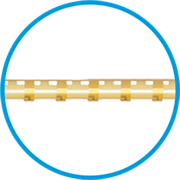The risks of canaloplasty with the Stegmann Canal Expander® were shown to be quite similar to Canaloplasty without the Stegmann Canal Expander®.
Just over one quarter of patients experienced a hyphema (blood in the front part of the eye). However, this is viewed by most Canaloplasty surgeons as a desirable finding. Why? Because it provides confirmation that the eye’s drainage system has been reopened by the surgery. Indeed, if I do not see at least a small (”micro”) hyphema the day after Canaloplasty I worry that the glaucoma surgery may not be effective.
The Stegmann Canal Expander® is the first implantable device into Schlemm canal to treat effectively glaucoma. The Stegmann Canal Expander® is a powerful biocompatible, non-metal, non-gelatin micro-implant and was approved for the European market (CE mark 0124) in 2012.
Source: Canal Expander | Canal Expander [Internet]. Canalexpander.com. 2017 [cited 2017 Mar 18]. Available from: http://www.canalexpander.com/canal-expander/
A temporary elevation of IOP above 25mmHg was noted in 7.2% of surgeries. Only one patient, however, experienced hypotony (an IOP that is too low) which improved over time without loss of vision.
Descemet’s detachment (gel-filled “bubble” under the cornea) was also encountered in 7.2% of these glaucoma surgeries. As with most Descemet’s detachments seen with Canaloplasty, these were mild and did not reduce vision.
Worth noting is that in about one out of twenty surgeries (~5%) the eye could not be fully catheterized. This is a “risk” only in that the IOP may not be lowered as much when Schlemm’s canal is not fully dilated.
Importantly, no infections, worsening of cataracts, implant dislocations, or significant changes in vision were noted over the two-year study.
In The Same Series:
- Canaloplasty with the Stegmann Canal Expander®
- How Well Does the Stegmann Canal Expander® Work?
- Risks of Canaloplasty with the Stegmann Canal Expander®
- Comparison to Canaloplasty without the Stegmann Canal Expander®
- Who Will Likely Benefit from the Stegmann Canal Expander®?
Related Articles:

David Richardson, MD
Medical Director, San Marino Eye
David Richardson, M.D. is recognized as one of the top cataract and glaucoma surgeons in the US and is among an elite group of glaucoma surgeons in the country performing the highly specialized canaloplasty procedure. Morever, Dr. Richardson is one of only a few surgeons in the greater Los Angeles area that performs MicroPulse P3™ "Cyclophotocoagulation" (MP3) glaucoma laser surgery. Dr. Richardson graduated Magna Cum Laude from the University of Southern California and earned his Medical Degree from Harvard Medical School. He completed his ophthalmology residency at the LAC+USC Medical Center/ Doheny Eye Institute. Dr. Richardson is also an Ambassador of Glaucoma Research Foundation.



